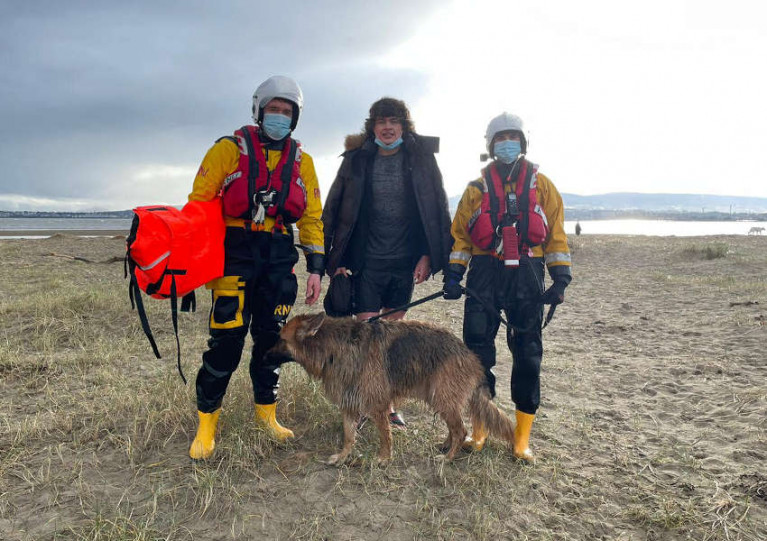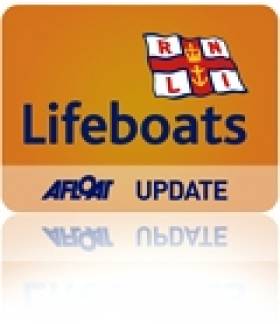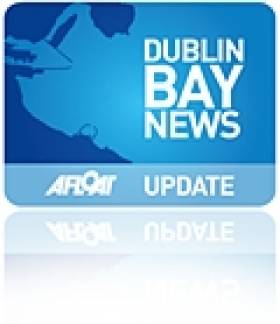Displaying items by tag: Sandymount
Calls for Greater Public Awareness of Tidal Risks After Three Rescued Off Sandymount
Calls have been made for greater public awareness over the risks of incoming tides after three people were rescued off Sandymount earlier this week.
A multi-agency response involving Dun Laoghaire RNLI and the Irish Coast Guard’s Dublin-based helicopter Rescue 116 led to the casualties’ successful retrieval after they became stranded on a sandbank on Tuesday (26 April).
Speaking to Independent.ie, a local councillor called for a major advertising campaign to highlight the dangers of tides at Sandymount, which has become notorious for such incidents.
“This happens far too often and the Coast Guard use a huge amount of resources every year to rescue people who find themselves in this situation,” Fine Gael’s Cllr James Geoghegan said. Independent.ie has more on the story HERE.
The news comes in the same week as a joint appeal from the coastguard, RNLI and Water Safety Ireland to take care when on or near the water this May Bank Holiday weekend, as reported earlier on Afloat.ie.
A dog and his walker were rescued after they got cut off by the tide at Sandymount this afternoon (Thursday 4 February).
Dun Laoghaire RNLI’s inshore lifeboat assisted with recovering the duo from the water and bringing them to safety at Poolbeg beach.
National Ambulance Service paramedics arrived to give the owner a medical check-up.
At the same time, an Irish Coast Guard member and a paramedic gave Hugo the dog some TLC after his dramatic experience, as Hugo can’t swim.
Dun Laoghaire’s coastguard unit reminds the public if you see anyone in difficulty in or near the water, dial 112/999 immediately and ask for the coastguard.
The Irish Coast Guard’s Dun Laoghaire unit launched to the rescue of a family of four cut off by the tide on Sandymount yesterday afternoon, Saturday 25 July.
Dun Laoghaire Coast Guard were tasked to incident along with the local RNLI’s inshore lifeboat and the Dublin-based coastguard helicopter Rescue 116.
The two adults and two children were retrieved from their sandbank by the helicopter crew, who landed them at a safe spot on land where they wiremen by a coastguard team. All were found to be in good spirts.
Emergency services remind the public if you see anyone in difficulty in or near the water to dial 112/999 immediately and ask for the coastguard.
Dublin Beaches Closed To Swimmers After Liffey Sewage Spill
#Pollution - The beaches at Dollymount and Sandymount on Dublin Bay have been closed to swimmers after a sewage spill in the Liffey caused by heavy rain on Thursday (8 June).
According to BreakingNews.ie, swimming is banned at both of the popular city bathing spots pending the results from water samples expected tomorrow (Monday 12 June).
It comes just weeks after two Dublin region coastal beaches lost their Blue Flag status in the latest list of EU beach quality awards.
That announcement followed days from the news that three other Dublin beaches — including Merrion Strand, adjacent to Sandymount — had failed to meet the minimum standards for bathing water quality.
#DublinBay - A motorway across Dublin Bay? City councillors are opposed, but State policy may make its construction inevitable, as Louisa McGrath writes in the Dublin Inquirer.
Proposals for a new stretch of high-capacity road running across or under Sandymount have been mooted for decades, with the current iteration put forward by the National Transport Authority (NTA) intended as a completion of the M50 as a ring road for the capital.
But it's prompted a stand-off with Dublin City Council, whose members recently passed nine motions to block any bypass connecting the Port Tunnel to the southern section of the M50.
They have modern civic planning – which prioritises public transport over more roads and congestion – on their side, not to mention the potential impact on South Dublin Bay communities, and the area's Biosphere status.
However, national policy has already been signed off in spite of such concerns, and the removal the bypass from the city development plan may even be in breach of the law.
As Green Party leader Eamon Ryan writes in today's Irish Independent, the situation is a "mess".
The Dublin Inquirer has much more on the story HERE.
Dun Laoghaire RNLI Lifeboats Called out for 3 Teenagers Stranded in Fog on Sandymount Beach
#rnli – Both the Dun Laoghaire RNLI all weather and inshore lifeboats were launched yesterday evening (Tuesday 22 July) when three teenage girls, who were walking on Sandymount Strand on Dublin Bay, became disorientated when a heavy fog rolled in and they became cut off by the incoming tide. The teenagers found themselves surrounded by water with little visibility and temperatures dropping.
The Dun Laoghaire inshore lifeboat was launched at 6.22pm with the all-weather lifeboat launching a few minutes later. The girls had called for help on their mobile phone when they realised they were lost and surrounded by water on all sides. Both the Gardaí and the Dun Laoghaire Coast Guard Unit joined in the search from the shore.
The lifeboat crew were operating with only one hundred metres of visibility in front of them. Approximately ten minutes after the lifeboat crews had launched, the girls heard the noise from the shore based teams that were searching for them and they were able to answer them. Dun Laoghaire RNLI's inshore lifeboat was alerted to their position by the Coast Guard from the shore and lifeboat crews transferred the three girls onto the inshore lifeboat. They were all extremely cold and were met at the lifeboat station by paramedics, to be assessed.
Commenting on the callout Dun Laoghaire RNLI Coxswain Mark McGibney said, 'The teenagers were out for a walk when they were caught out by a rolling fog and a fast incoming tide. They lost their bearings and were quickly surrounded by rising water. Thankfully they stayed calm and called for help. Our lifeboats were launched in minutes and assistance was also given by the Gardaí and local Coast Guard. If they had walked in the wrong direction they could have quickly become out of their depth, instead they made the right decision and called for help. In this case thankfully it ended well.'
#DublinBay - Following our previous story on the swimming ban at four South Dublin beaches due to high levels of E.coli and other bacteria in water samples earlier this week, Dun Laoghaire-Rathdown County Council announced on its Twitter account this afternoon that it was lifting its prohibition notices from the beaches at White Rock in Dalkey and Killiney, with the latter also seeing its Blue Flag raised again.
Results from tests at Sandymount were also clear, but as RTÉ News reports, emergency overflow into Dublin Bay from the city drainage network as a result of this morning's heavy rainfall has seen that beach's temporary swimming ban replaced with a 'Bathing Water Advisory Notice', with further tests to be carried out this evening.
#DublinBay - Four bathing spots in South Dublin have been temporarily closed to swimmers after water tests indicated levels of bacteria above the minimum health standards.
As TheJournal.ie reports, Killiney Beach will have its Blue Flag status suspended by Dun Laoghaire-Rathdown County Council pending the investigation into the high levels of E.coli and Enterococci detected in water samples taken yesterday (16 July).
The popular White Rock beach in nearby Dalkey has also been closed to bathers, while Dublin City Council has prohibited swimming at Sandymount Strand and the South Wall after its own water quality tests.
Waters at all four Dublin Bay locations have been resampled with results due tomorrow (Friday 18 July).
Easy Swim at Forty Foot on Warmest Christmas Day in Years
#WEATHER - Those hardy Yuletide bathers at the Forty Foot in Dublin didn't need to be so brave this year, as Ireland experienced one of the warmest Christmas Days on record.
Just one year ago Ireland was in the grip of a deep freeze. But as the Irish Independent reports, temperatures on Sunday last rose to as much as 14.4 degrees in Co Cork.
It's been almost a decade since late December temperatures reached such levels, when Christmas in 2002 saw highs of 14.6 degrees according to Met Éireann records.
Sunny spells on the east coast brought out the polar bear plungers to Sandymount and the Grand Canal as well as the famous Forty Foot bathing spot in Sandycove.
The Irish Independent has more on the story HERE.
Angling Classic Among Items Auctioned from Hanna Collection
A 19th-century book on angling fetched €820 at an auction of bookseller Fred Hanna's private collection earlier this week, The Irish Times reports.
The classic title The Erne, Its Legends and Its Fly Fishing by the Rev Henry Newland exceeded its auction estimate of €500-€700 when it went under the hammer in Ballsbridge on Tuesday.
It was one of many rare books and other items that sold from the late bookseller's collection for a total of €350,000.
Other marine-related items included Lady Gregory's copy of JM Synge's The Aran Islands with drawings by Jack B Yeats, which sold for €12,000, and a first edition of Jame Joyce's Ulysses - much of which is set in the coastal suburb of Sandymount - which fetched €8,250.





































































